Seeds aren’t trash. The best avocado varieties in the world have all come from someone planting a seed. Gwen, Fuerte, Hass, Nabal, Reed, etc. They all came from seeds — seeds that someone allowed to grow.
Maybe you want to try your luck and see if a seed you plant will grow into a tree with great fruit or a strong rootstock, or maybe you just want to discover how an avocado tree develops from the beginning. Any way, here is my experience to help you along.
Where to get avocado seeds?
Almost every avocado you eat has a seed in it that will grow into a tree. A seed from an avocado from your own tree will grow, as will a seed from a store-bought fruit.
Here is a tree that grew from a seed inside a Hass avocado bought at Costco:
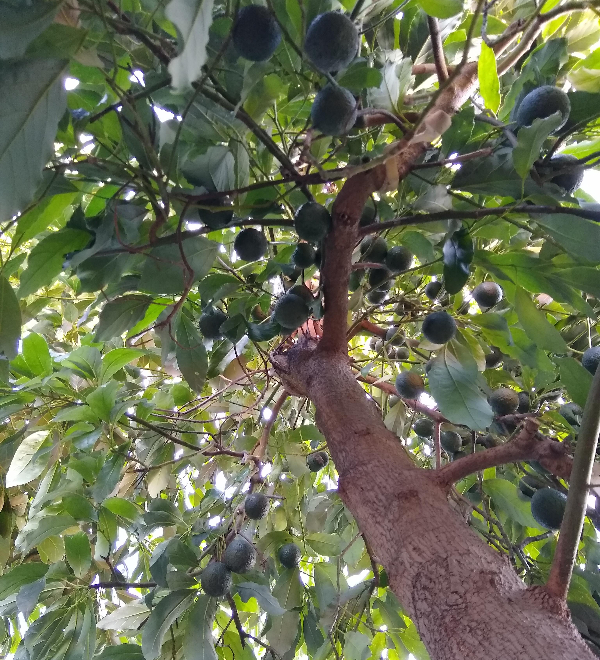
A fellow Yard Posts reader grew this tree. The tree is fruitful, and the avocados are delicious.
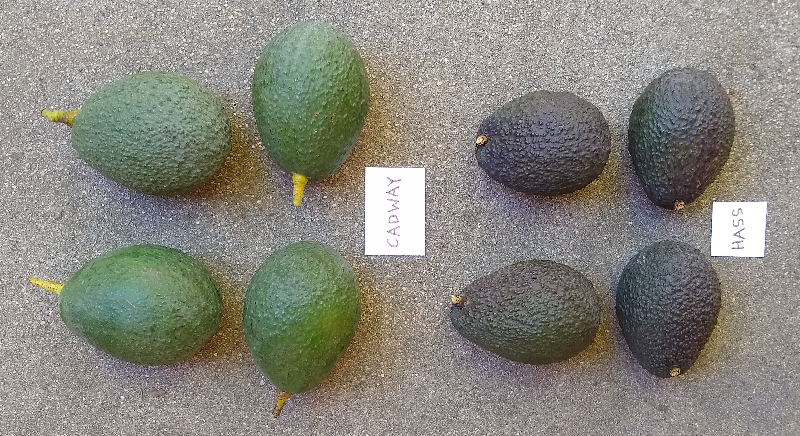
(See my profile of the Cadway avocado here.)
The lesson is that anyone can hit the jackpot; you don’t need a special source for special seeds.
You do want to be sure to plant a seed that is mature though. Judge this by how the fruit tastes. If the avocado tastes good, then it is mature and so is the seed. You can also judge based on the color of the seedcoat, which will get browner the more mature the seed is.
Seed treatments
Do you need to do anything to the seed before you plant it? This is not necessary.
Avocado seeds will grow without any treatment. Under avocado trees you often find seedlings growing out of the leaf litter because a fruit has dropped, rotted on the ground, and then the seed germinated. Here is one such seedling I noticed the other day under my Lamb tree:
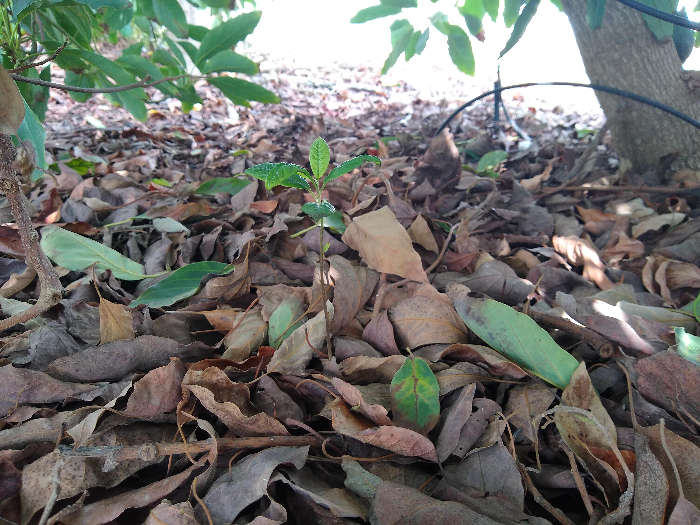
That said, seed treatments have been tested, and it has been found that some treatments speed up germination. Peeling off the seedcoat appears to hasten germination, at least in some varieties. (See “Effect of the Removal of Seed Coats on Avocado Seed Germination” by E.R. Eggers.)
Also, if seeds have been stored in refrigeration (which they can be, in order to keep them viable for a month or two), germination will be enhanced if the seeds have their coats removed and parts of the seeds are sliced. (See “The Effects of Pretreatments on Avocado Seed Germination” by Bob Bergh.)
Once, I treated a group of fresh seeds (hadn’t been stored in the fridge) by either slicing off tops or just removing seedcoats, and I found similar germination in all.
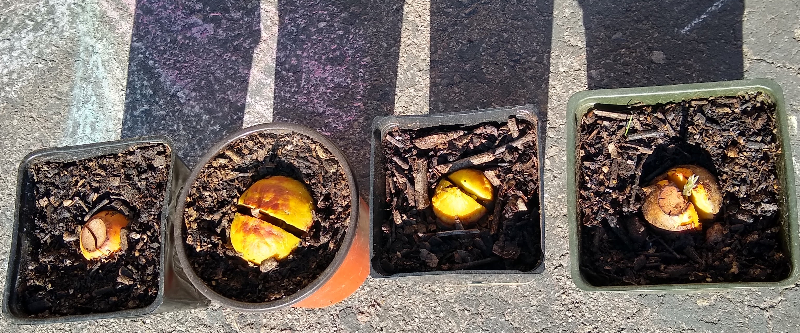
So my personal routine these days is to let a seed dry for a couple days so that the seedcoat cracks, then I peel it off partially, and then I plant. This gives me reliable germination.
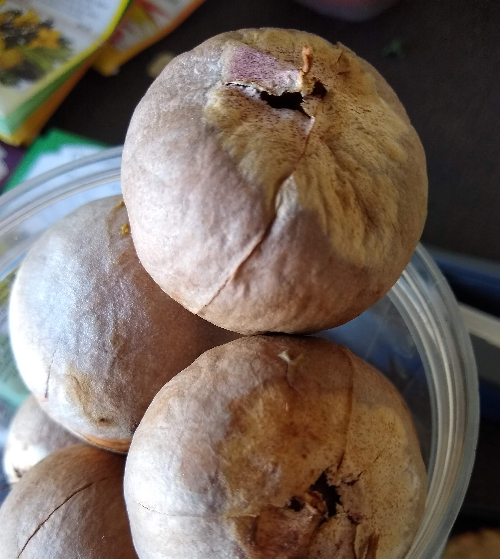
Where to plant? In water
Most of us who grew up in California germinated avocado seeds in a cup of water using toothpicks at some time in our youth. That method still works in the 21st century.
It also works to start an avocado seed growing in water using something else for suspension. A member of the California Rare Fruit Growers in San Diego County makes these boats for the purpose:
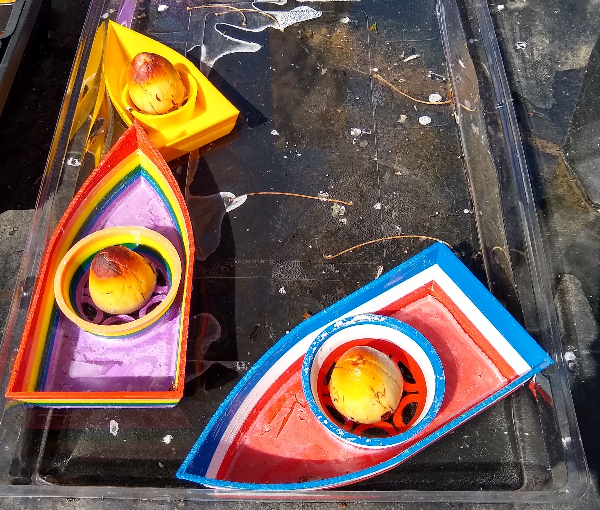
Note that no matter the method, the avocado seed does not need any sunlight in order to start growing. And sunlight that is too intense burns the seed, as shown by the browing of the tops of the seeds in the photo above.
Where to plant? Under a tree
Because avocado seeds don’t need sunlight to germinate, but they do need moisture, I have often started them under large trees. I choose a spot that stays moist via irrigation and stick the seeds about halfway into the dirt and cover the top of the seed with mulch.
You can do this under any kind of tree; it doesn’t need to be an avocado tree. I have most often used a large orange tree in my yard. In fact, I’ve germinated too many avocado seeds under that tree. Many still grow there because I haven’t harvested them.
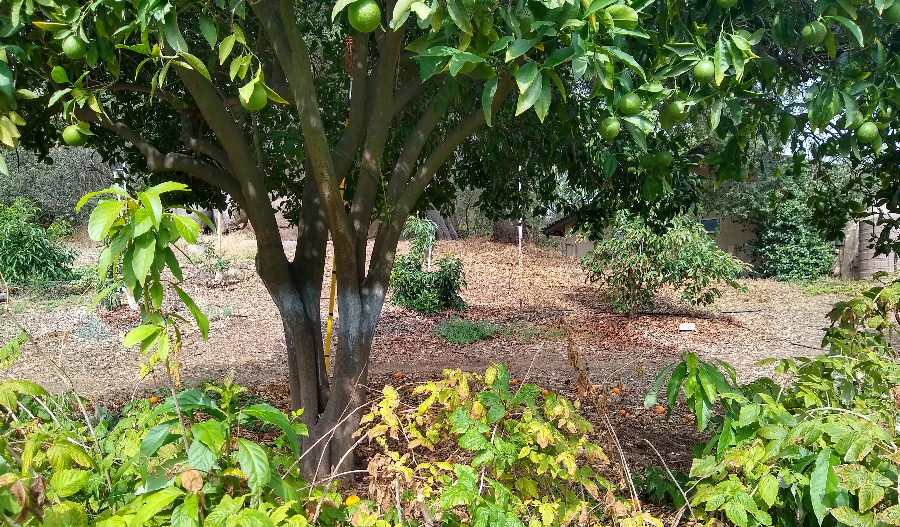
Where to plant? In a container
More often these days, I start avocado seeds in containers. It takes a bit more attention to start an avocado seed in a container compared to in water or under a tree because you must maintain proper moisture within the container, but the advantage is that you have no need to transplant the seedling as soon.
It is better to use a container that is tall and slender as opposed to short and wide. This is due to how an avocado seed grows. (More on that below.)
Soil or mixes to plant in
What to fill a container with? Lots of mixes work, and individuals and nurseries use different ones with good results. The common characteristic of these mixes is that they are light, airy, and fast draining.
When I germinate avocado seeds in containers these days I use homemade compost. I have germinated avocado seeds in the past in containers filled with dirt taken straight out of my yard. That can work too, but it is trickier to keep the moisture level right.
A mix that you can buy at many garden centers that works well for one of my friends who grows many avocado seeds for rootstock is E.B. Stone’s Cactus and Succulent mix, which contains pumice, aged fir, aged redwood, lava rock, and sand.
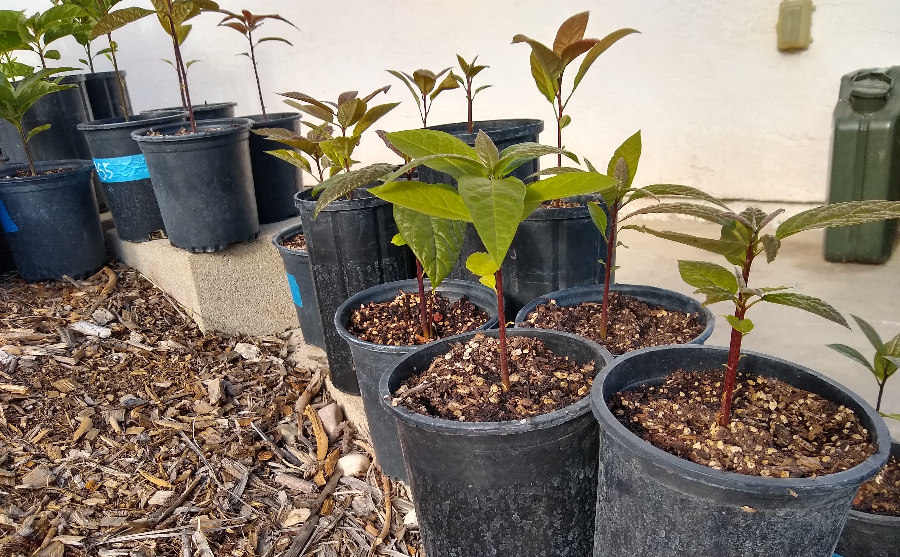
Professionals have used different blends over the years. Back in the 1960s when Bob Bergh was planting thousands of avocado seeds at U.C. Riverside for breeding, he wrote that he got good results from a “mix of two parts soil to one part peat moss to one part sand.”
Later, breeders and nurserymen stopped using soil in their mix. “Mixes of 3 parts peat moss to 2 parts perlite or 1/3 peat, 1/3 perlite and 1/3 vermiculite are used,” wrote R.G. Platt of the common mixes used in 1976.
Nowadays, coconut coir is often used instead of peat. For example, Brokaw Nursery of Ventura County uses coconut coir and perlite in which to germinate their avocado seeds for rootstock. (They later add materials once the seeds are up and growing.)
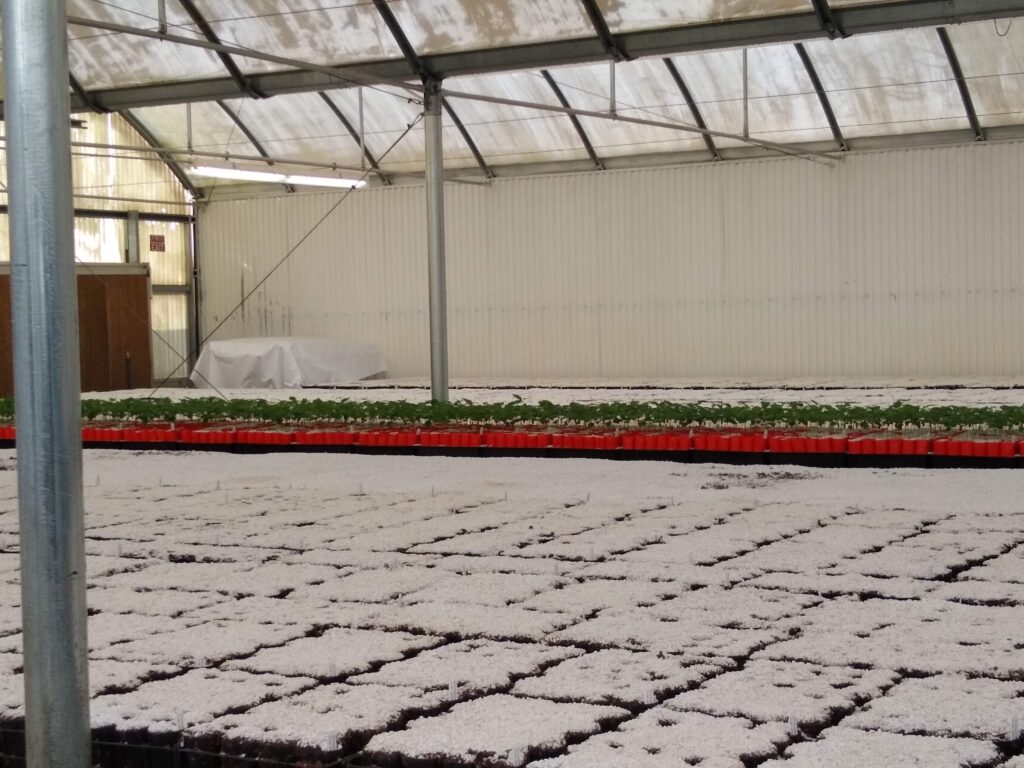
How to plant the seed
Now for the actual planting. First, make sure you orient the seed correctly. The top of the seed is toward the stem; this is where the leaves will come out, and it is sometimes a bit more pointy than the bottom.
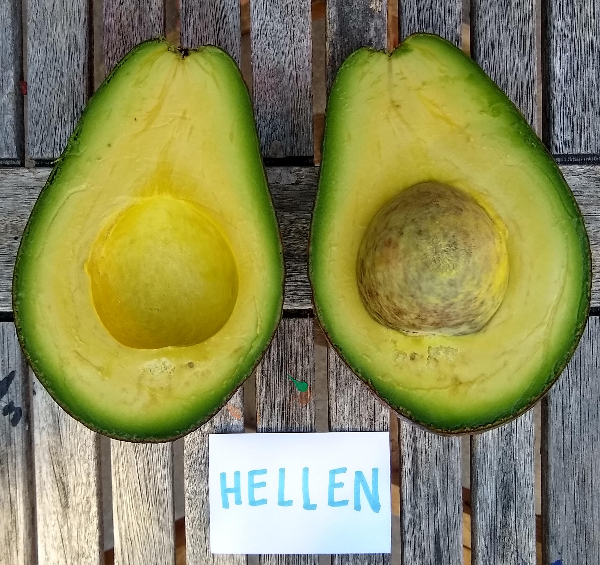
The bottom of the seed, farthest from the stem, is where the roots will come out, and that side needs to be in the dirt or soil mix or water.
If planting in a container or ground, you don’t need to entirely cover the seed. You can leave the tip of the seed showing. This helps ensure that the seed has enough air, as it is vulnerable to rotting if totally covered and kept too wet.
Likewise if starting the seed in water: don’t entirely submerge it. Leave the tip out of the water.
No matter where it’s planted, the bottom half of the seed needs to remain moist in order to start growing. The easiest way to accomplish this if starting in the ground or in a container is to start with completely soaked dirt or mix on planting day. From there, add water only as the dirt or mix dries around the seed.
Time to germination
How long until sprouting? This depends on a few factors, the most important of which is temperature. At a temperature in the range of daily highs at 75-80 degrees F, an avocado seed will sprout in around a month. It can be up to grafting size within two months.
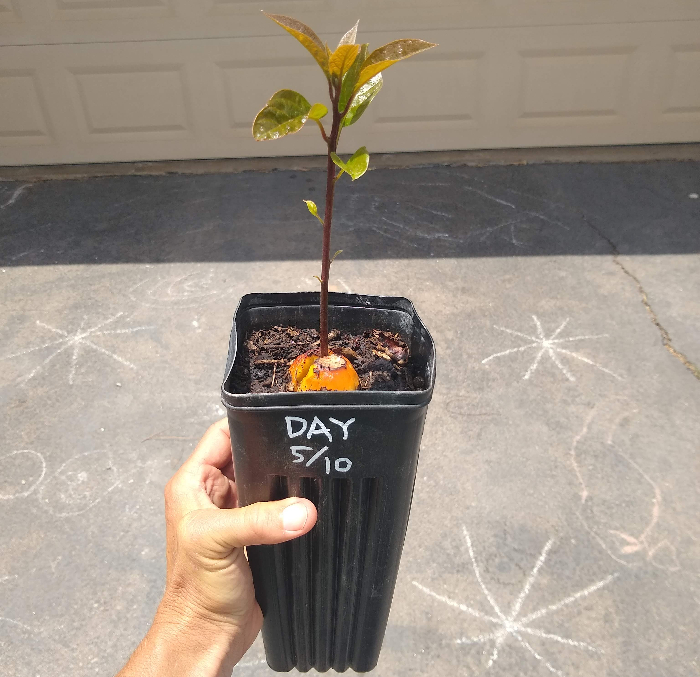
When to plant avocado seeds
If daily highs are much cooler than 75 degrees, then germination will be slower. So planting in the spring, summer, or fall is best in terms of giving a seed temperatures in which to sprout the fastest.
If you go into an avocado nursery greenhouse, you notice that it feels warm and humid; it’s usually in the 75-80 degree range.
How avocado seeds start growing
An avocado seed looks like a big nut. It is actually two hemispheres called cotyledons that have a bunch of energy stored like a battery that can power a new plant until the new plant can glean energy on its own.
The two halves of the avocado seed split open and a root emerges from the bottom. You can find this happening inside an avocado fruit if the fruit is very mature.
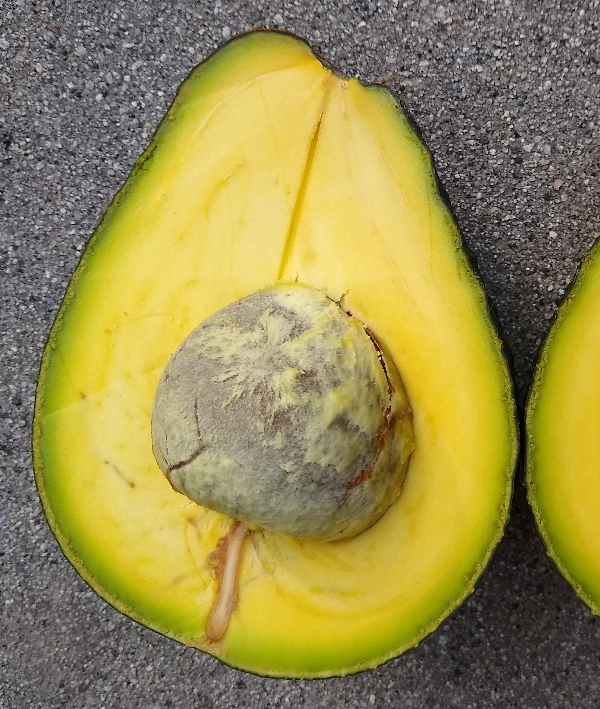
So the root emerges first, before any leaves. That’s one thing to keep in mind.
Secondly, know that the root is singular, straight, and heads deep as long as it’s allowed. If you have a tall container, then the avocado seed can send that tap root down far. If you have a short container, then the tap root quickly hits the bottom. All is not lost, but the incipient tree is somewhat stunted.
Here are two seeds I germinated, one in a tall container and one in a short container.
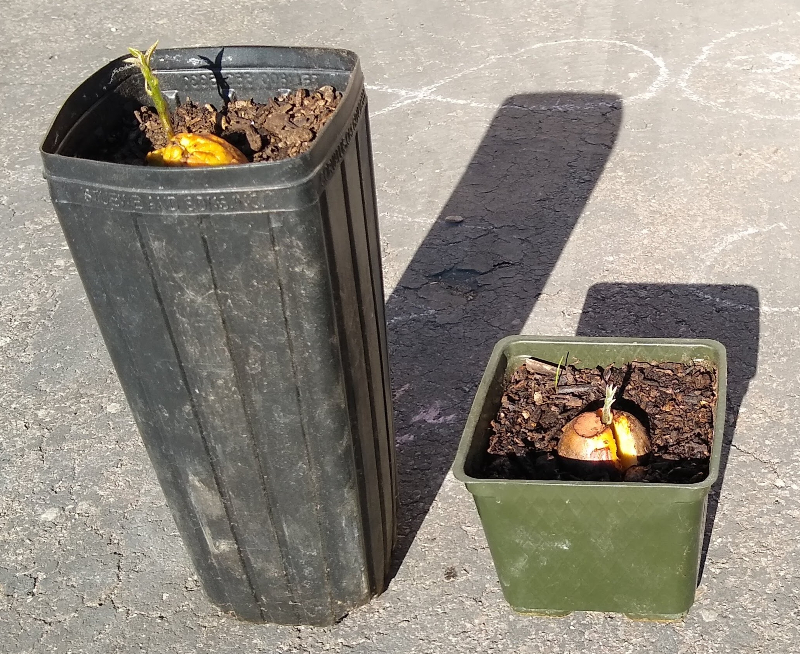
Look at how the roots in the short one have already hit bottom (even though the sprout on top has barely emerged):
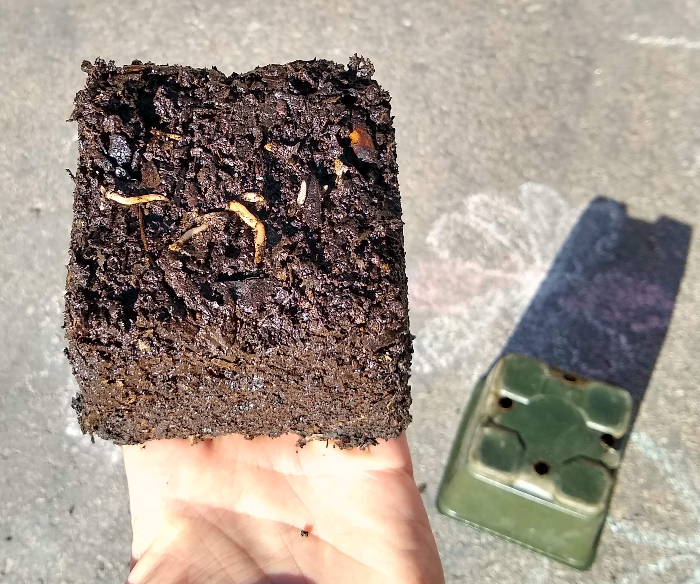
Tall and slender containers are best, and you won’t find professionals using anything else.
When to transplant avocado seedlings
After the little guy has sprouted, what should you do with it? If it’s in water, then you’ll need to get it into a mix that has some nutrients. If it’s in a container, then you can let it grow until it has outsized its container. When that is depends on how big the container is. Check for roots circling on the bottom and up-pot when you find that.
If it’s in the ground (such as under my orange tree), then you ought to dig it out sooner rather than later, as it becomes harder to avoid damaging roots as they dive deeper and deeper. Avocados are known to be shallow-rooted trees once mature, but when they begin life as a seed they first send roots deep.
Congratulations
Now you’ve grown an avocado tree from the very beginning. Keep it in a pot? Plant it in the ground? Use it as rootstock and graft onto it? Oh, the possibilities.
Below is a tree that I started as a seed from a Gwen avocado planted under my orange tree. I dug out the seedling after it sprouted, potted it up, then grafted a Gwen scion on top. Later, I transplanted it into the ground where it happily grows today.
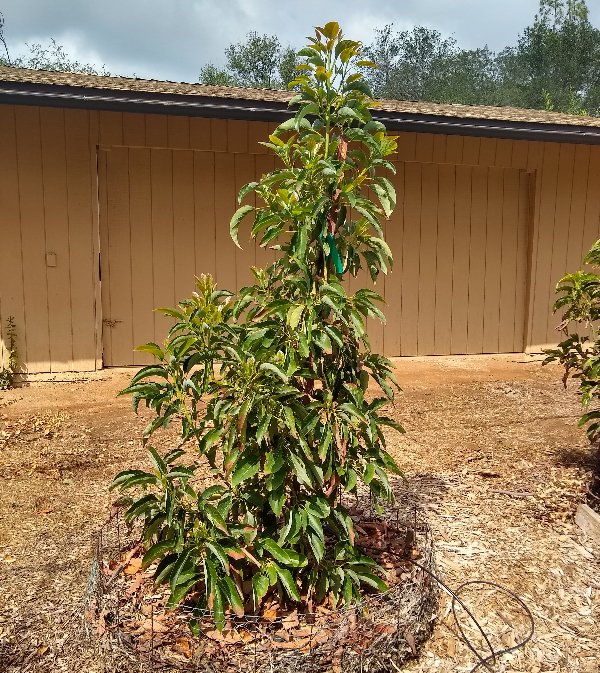
And here is a video of a seed that sprouted from a compost heap in my mom’s backyard and was allowed to grow in place:
(I’ll soon write a post about growing avocado trees in containers.)
(You might also like to read my post about what kind of avocados you can expect to get from a tree that you grow from seed.)
All of my Yard Posts are listed HERE
Thank you, Supporters! I can write these posts and never run an ad because of you. (Here’s how to support.)




I’m amazed by the number of grafts on this tree. I have read the books and seen the ones you have done, after 3 years of trying I’m not able to get a graft to stick. Greg, would show us how you do it.
Bummer, David. Have you seen this post?: https://gregalder.com/yardposts/grafting-avocados/
What kind of graft are you trying? What size of tree are you grafting onto?
My latest attempt was a “T” grafting a budd from Fuentes onto a two year old Reed that grew from a seed. It looks like the budd is starting to swell.
I think i will try the side graft next.
Hi David,
I find cleft grafts and side grafts most successful on avocados unless you’re working with big stocks (in which case a bark graft might be best).
Good day Dave
I”m from the South Coast in South Africa and hope you can still help as you’ve done years ago.The last 4 fuerte seedlings2 year old and 2lemon to naartjie, problem is they were grafted 3to 4 months ago and still no shoots but still green and wound seems to be closing just fine
I’m currently trying! They’ve split, but that’s all. They’re Mexicola (regular), and I read those may breed true to seed. I’ve had them in peat for about 5 weeks.
Hi Jessica,
Sounds like things are going right, and if they’ve split then the seeds may already have roots down even though a sprout isn’t showing on top.
🤞🤞🤞
Just came across a video of a guy who grew a tree from a Hass seed! He said the seed is large but the fruit is good quality. I think I will stop dissuading people from growing seedlings from grocery avocados. It seems the success rate is much higher than we’ve been led to believe.
https://youtu.be/anUdo8tZlh0?si=1Wdrp0EPMU_ZsQc4
Hi Jessica,
I agree that no one should be dissuaded from growing avocado trees from seed. It’s just good if they know what they’re going to get from that seed.
I wrote this post: “What kind of avocado tree do you get from a seed?”
Your rate of success just depends on what you define as success. If you’re looking for a tree that makes edible avocados, your success rate will be near 100%. If you’re looking for a tree that makes avocados that are as good as the best ones, your success rate will be down near 1%. If you’re looking for a tree that makes excellent avocados and makes a lot of them and has desirable qualities such as extra heat tolerance or cold tolerance, then the likelihood of that is one in a million.
Nevertheless, I think we should all be growing some seedlings in our yards and farms. I plant seeds here and there in my yard, and I even guerrilla plant them where I see municipalities wasting irrigation in road medians and school campuses, etc. I’m convinced that this is where most of our future superior varieties will come from. Professional breeders do not have the capacity to plant out as many seeds as we millions of avocado eaters and gardeners and farmers do. And when we luck upon something good, we can share.
I have two beautiful avocado trees in large pots, that I started from Reed avocado seeds. They are now about 30 inches tall and the tops are filling in. I have the pots fairly close to my Fuerte tree, hoping that the proximity, when and if they bloom, will encourage more fruit from my Fuerte! I originally started the seeds in a container with water, using the “old” method of toothpicks.
Where do you find your tall, slender potting containers? I’ve checked home despot, Amazon, etc and not been able to find any. And they can’t ship the soft plastic (garbage bag material) sleeves to California.
Hi Dan,
It’s good to see once again that California has its priorities straight.
Search on Amazon or elsewhere for “8 Inch Deep Treepots – Budding Seedling Grafting” and you should find some hard plastic ones that are allowed to be shipped to California.
Alternatively, make your own from half-gallon milk containers, coffee containers from Trader Joe’s, or oatmeal containers. They are all about the right shape. Just poke some holes around the bottom and paint or cover the sides if they’re transparent and you’re good to go.
Also, nurseries often have discards of these types of things. If you’re at a nursery, it can’t hurt to ask. You want to start avocado seeds in containers roughly three inches wide and nine inches tall.
Is there any way to keep an avocado tree in a pot indoors during winter months in NY?
Hi Megan,
Yes. The key is to give it as much light as possible. Near a south-facing window is usually best.
Do you recommending pruning new seedlings? I’ve read that once a seedling gets to 12inches to prune it back to 6 inches. Would you recommend that or just let it grow?
Hi Vincent,
I wonder why someone would do that. Maybe to get the tree to branch at the six-inch level?
I’ve never heard of doing that, and I don’t do it myself. I let seedlings grow. If I’m going to graft them, then I graft them whenever the diameter of the stem/trunk is up to size.
If you are successful in getting a seed to grow in a container and later plant in the ground, do you use this tree for grafting/rootstock? Otherwise, am I correct this seedling won’t produce any fruit for about 10 years
Hi Laura,
You can use the seedling for rootstock and graft onto it, yes. This is what I often do. Otherwise, the seedling will take some years to produce fruit, but it’s usually less than 10.
One other option is to take a scion from the seedling and graft it onto a mature tree. This induces the scion to make fruit earlier than the seedling will so you can discover what its fruit is like faster.
Hi Greg,
They still haven’t made a parking lot out of that 1 or 2 acre mystery avocado tree lot around the corner from me here in Simi Valley. The grounds keeper said he thought there were Fuerte, Hass, Bacon, Puebla and a couple of others that I can’t remember (I wish I had taken a recorder or even a pencil and paper with me) But in the mean time, a note to you, Dan and anyone else that is looking for tall thin potting containers. Check Stuewe & Sons Inc. website. I ordered 60 containers 4″ x 4″ x 13″ and they arrived in just two days. They are perfect, deep, spacious and sturdy with 5 holes in the bottom. I’m looking forward to when my Zutano seeds are mature enough (in a couple of months)to start some seedlings for grafting.
Hi Greg,
I may have missed the answer to this somewhere so apologies if I did!
I planted a Hass (purchased), a tree from seed (I’m guessing Bacon) and a guava in the ground early last month. All are about 3 feet tall. I’m inland a bit where temps will get to about 37 a few times a month during winter. Should I cover these young trees?
Hi Andie,
If temps only drop to high 30s a few times a month during winter, there’s no need to protect those trees throughout the season. My rule of thumb is to protect such trees when temps are predicted to be 32 or below. There will be no damage at 32, but always the predictions of meteorologists are somewhat off so there’s a chance the temps will get below 30, when damage will occur. See this post for more: https://gregalder.com/yardposts/protecting-avocado-trees-from-cold/
I planted a reed Avocado from seed. The tree is about 5 years old and 20 feet tall and has never produced one reed avocado on it all this time. It gets water, I’ve fertilized it and still it does not produce any avocados. It is located in a shade and partial sun area. what can I do to get it to produce avocados??
Here’s a great post about what you get when you plant an avo seed and let it grow.
https://gregalder.com/yardposts/what-kind-of-avocado-tree-do-you-get-when-you-plant-a-seed/
Long and short of it is that you won’t get a Reed tree from a Reed seed. But if you get great avos, maybe you’ll have the Patricia Avocado!
5 years and 20ft and no fruit is about right. It can take 7 years or more to produce, if it ever does produce. The article linked above provides a great story about a tree grown from seed and how long it took to be fruitful.
But with a healthy tree like that, you can always graft on a Reed branch! Or several different varieties (Reed and Hass maybe?). Or have it “top worked” and just have one giant Reed. (Top working as I understand it is to cut the tree down about 3-4 feet from the ground and graft on whatever tree you want. It will grow back surprisingly fast!)
lets play a game of three questions.
1. will my tree grow fruit. my tree seed came from woolworths.
2. when will i be able to move it outside? i put it in a water pit with a smoothie glass and it grew thick roots but no stem. but at spring it shot up ans after one month it is 1.5 ft. i have hardened it a bit by moving it outside every once and a while. i live at nz auckland so it refuses to grow unless it is spring or summer.
3. i read some other instructions and it says to trim the leaves at the top every time it grows a few inches. is that a bright idea or will it damage the plant.
why did i even attempt this. poor me
Hi Jack,
There’s no benefit to trimming the leaves. Just let the little tree grow. It will almost certainly produce fruit eventually, as almost every avocado tree grown from seed does.